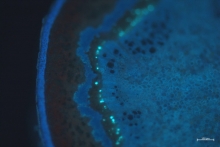You are here
Bullard Spotlight: Isabelle Chuine on What Makes Spring Buds Burst

Every quarter, we highlight the work of one of our visiting Charles Bullard Fellows. Isabelle Chuine is a research director at the Centre of Functional and Evolutionary Ecology in Montpellier, France. Her research lies at the interface of functional ecology and evolutionary ecology and focuses on seasonal change in forest trees, especially as climate warms. She uses a combination of modelling, experimental work in field and controlled conditions, and long-term monitoring of natural populations to develop models that forecast tree species distribution and phenology for the coming centuries.
During her Bullard Fellowship, Chuine is based mainly at the Arnold Arboretum, conducting experiments on the factors that determine bud dormancy in trees growing at Harvard Forest (red oak, yellow birch, sugar maple, beech) -- the same trees that have been annually monitored for spring bud burst and fall leaf drop for over 25 years by HF ecologist John O'Keefe. Chuine's experiments seek to determine the optimal temperatures that release bud dormancy and trigger bud cells to grow. Current models predict that as climate warms, by the end of the 21st century, tree species with specific requirements for winter dormancy may not be able to produce leaves from their buds in spring.
Chuine came to Harvard, she says, for "the amazing facilities available at the Arnold Arboretum, especially the growth chambers and the microscopy lab" and "inspiring discussions with people at Harvard Forest." She describes her fellowship work as "very intensive, but very exciting and fruitful."
- Explore Chuine's citizen-science based national observatory of phenology in France: the Observatoire des Saisons.
- Learn more about Bullard Fellowships and explore more Bullard spotlights.
(Photo of bud sections under microscopic epifluorescence with aniline blue staining of callose in the bud phloem - courtesy of Isabelle Chuine.)

